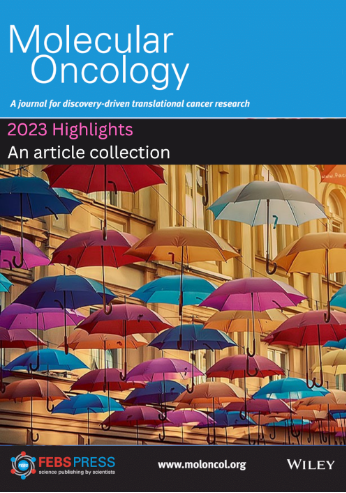High CD34 surface expression in BCP‐ALL predicts poor induction therapy response and is associated with altered expression of genes related to cell migration and adhesion
IF 5
2区 医学
Q1 ONCOLOGY
引用次数: 3
Abstract
Minimal residual disease (MRD) constitutes the most important prognostic factor in B‐cell precursor acute lymphoblastic leukemia (BCP‐ALL). Flow cytometry is widely used in MRD assessment, yet little is known regarding the effect of different immunophenotypic subsets on outcome. In this study of 200 BCP‐ALL patients, we found that a CD34‐positive, CD38 dim‐positive, nTdT dim‐positive immunophenotype on the leukemic blasts was associated with poor induction therapy response and predicted an MRD level at the end of induction therapy (EOI) of ≥ 0.001. CD34 expression was strongly and positively associated with EOI MRD, whereas CD34‐negative patients had a low relapse risk. Further, CD34 expression increased from diagnosis to relapse. CD34 is a stemness‐associated cell‐surface molecule, possibly involved in cell adhesion/migration or survival. Accordingly, genes associated with stemness were overrepresented among the most upregulated genes in CD34‐positive leukemias, and protein–protein interaction networks showed an overrepresentation of genes associated with cell migration, cell adhesion, and negative regulation of apoptosis. The present work is the first to demonstrate a CD34‐negative immunophenotype as a good prognostic factor in ALL, whereas high CD34 expression is associated with poor therapy response and an altered gene expression profile reminiscent of migrating cancer stem‐like cells.BCP‐ALL中CD34表面的高表达预示着诱导治疗反应较差,并且与细胞迁移和粘附相关基因的表达改变有关
微小残留病(MRD)是B细胞前体急性淋巴细胞白血病(BCP - ALL)最重要的预后因素。流式细胞术广泛应用于MRD评估,但关于不同免疫表型亚群对结果的影响知之甚少。在这项对200例BCP - ALL患者的研究中,我们发现白血病原细胞的CD34阳性、CD38阳性、nTdT阳性免疫表型与诱导治疗反应差相关,并预测诱导治疗结束时的MRD水平(EOI)≥0.001。CD34表达与EOI MRD呈正相关,而CD34阴性患者的复发风险较低。此外,从诊断到复发,CD34表达增加。CD34是一种与干细胞相关的细胞表面分子,可能参与细胞粘附/迁移或存活。因此,在CD34阳性白血病中,与干性相关的基因在上调最多的基因中被过度表达,蛋白-蛋白相互作用网络显示与细胞迁移、细胞粘附和细胞凋亡负调控相关的基因被过度表达。目前的工作首次证明了CD34阴性免疫表型是ALL的一个良好预后因素,而高CD34表达与治疗反应差和基因表达谱改变有关,使人想起迁移的癌症干细胞样细胞。
本文章由计算机程序翻译,如有差异,请以英文原文为准。
求助全文
约1分钟内获得全文
求助全文
来源期刊

Molecular Oncology
医学-肿瘤学
CiteScore
12.60
自引率
1.50%
发文量
203
审稿时长
6-12 weeks
期刊介绍:
Molecular Oncology highlights new discoveries, approaches, and technical developments, in basic, clinical and discovery-driven translational cancer research. It publishes research articles, reviews (by invitation only), and timely science policy articles.
The journal is now fully Open Access with all articles published over the past 10 years freely available.
 求助内容:
求助内容: 应助结果提醒方式:
应助结果提醒方式:


